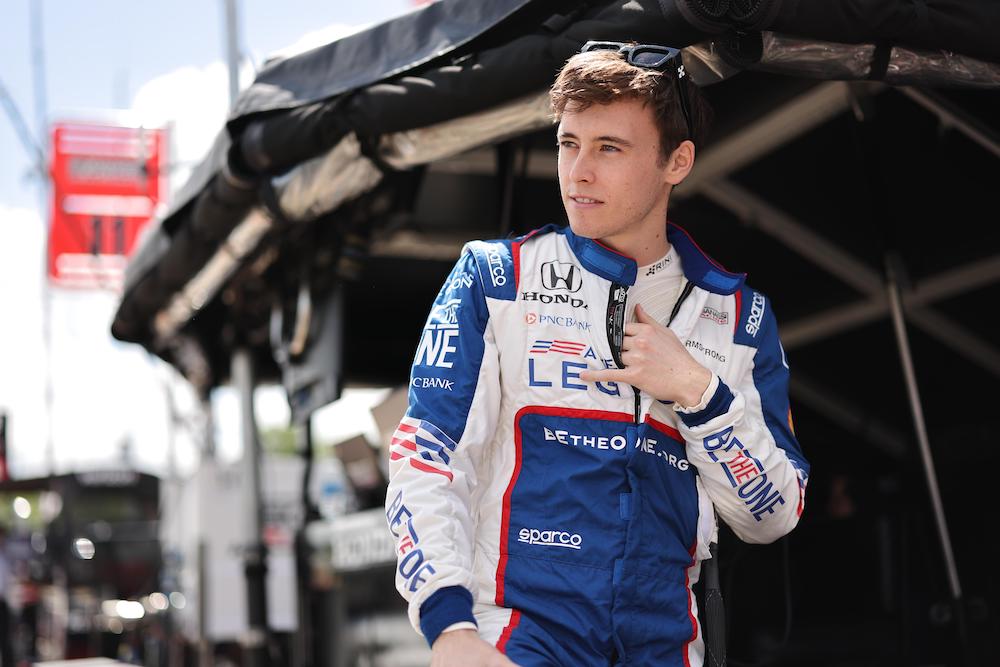Marcus Armstrong’s NTT IndyCar Series rookie season has brought both unusual opportunity and challenge for a newcomer. The young New Zealander, who made the move to IndyCar after three seasons in Formula 2, has a ride most veterans would covet at Chip Ganassi Racing, but he’s had to share the No. 11 Honda with Takuma Sato, who drives the car on the ovals. While that limits his opportunities to make an impression on the track, Armstrong stresses that he’s done all he can to make himself a full-time part of the team, and to make the most of its strengths.
“It isn’t difficult to sort of step in and out. I think throughout a season you always gain momentum and start to get into a rhythm,” Armstrong said.
“Obviously the two disciplines are very different, oval racing and street course racing. Whether or not one complements the other, I’m yet to find out!
“In any case, I’m at the races. I’m sitting on the stand. I’m doing everything but driving the car, so… I don’t feel like it’s messing with my own performance (to miss races). If anything, it’s helping it because I actually get the time to sit back and chitchat with people that I wouldn’t normally get the chance to do, talk a bit more personally, let’s say, with my teammates and everyone that I work with, just due to the fact that I have more time on my hands.”
He’s also making the most of his chances in the simulator between races — and by following his experienced teammates Scott Dixon, Alex Palou and Marcus Ericsson.
“I’ve done more hours on a simulator than I could possibly imagine,” he said. “Doing a simulator in Europe when I know the circuits is one thing. Doing it here preparing for a new circuit is a totally different game because I’m obviously seeing it for the first time. I prepare a lot more, I would say, from my sim sessions this season than I have in the past, just because I need to make the most of that time.
“Also the team is very helpful by allowing me to go normally last of the four drivers. That means that I get a whole lot of data to look at for when it’s my turn to drive.”

Another key Ganassi asset Armstrong has been maximizing is driver coach Dario Franchitti.
“Yeah, Dario has been really, really great. I think I’ve probably been on the phone to him about five times over the course of the last five days,” Armstrong said ahead of this weekend’s race on the streets of Nashville. “He certainly points me in the right direction. I often say that he needs to be more harsh with me, tell me what I’m doing wrong, because clearly I need to improve on stuff. But he seems to be very positive all the time about what we have been doing as a group, and what I’ve been doing and how I’m progressing.
“He’s very observant. He understands the sport probably better than anyone — equal with Scott Dixon, let’s say. So for him to be on my stand for the majority of the races this year, and also just to have a very good personal relationship with him, is clearly an advantage.”
Nashville will be Armstrong’s fifth street course outing, and he’s already come to appreciate the differences between U.S. street courses and the temporary circuits he raced on in F2 and F3.

“The circuits here are obviously bumpy. Not sure how to sugarcoat that!” he said. “It provides challenges that you can differentiate yourself to others, really.
“If I compare to, like, racing at Monaco or Baku or even Macau to a certain extent, they feel like road courses compared to a lot of these street courses, just because they’re very smooth. Monaco, it’s resurfaced every year. There’s not a single bump on the track. The biggest challenge is the fact that the wall is so close.
“Here there’s the bumps, which obviously create a big challenge on how to position the car. It obviously gives an advantage to the guys that know the circuits very well, because there’s so much character on the circuit that it actually takes time to find the sweet spot of where you need to place the car.
“I feel like that’s probably the biggest challenge — not necessarily the difficulty of the layout and the bumps and everything, it’s more just understanding it very quickly, because I have Scott Dixon who was doing those circuits before I was born. I need to learn quickly so I can start near the front. Normally towards the end of the race we’re well and truly on the pace. It’s just a matter of getting there quicker.”
Armstrong measures his progress more against his CGR teammates than by his position atop the Rookie of the Year standings, and although he’s coming off a season-best finish of seventh in his last time out at Toronto, he knows there is more to be had and that it’s on him to earn himself a full-time race role.
“The package is there, which is very reassuring,” he said. “Gives me a lot of motivation to do a good job really, because I know the car is capable of it.
“I mean, I haven’t exactly kept it a secret, but I’d love to stay here at Chip Ganassi Racing. I think I’ve been reasonably vocal about trying ovals for the first time. It would be a dream come true to compete at the Indy 500.
“It’s not really in my hands on the contractual side, let’s say. The team, it’s a very enjoyable environment and I feel like it’s all going in the right direction. I just have to keep pumping out some good results.”
